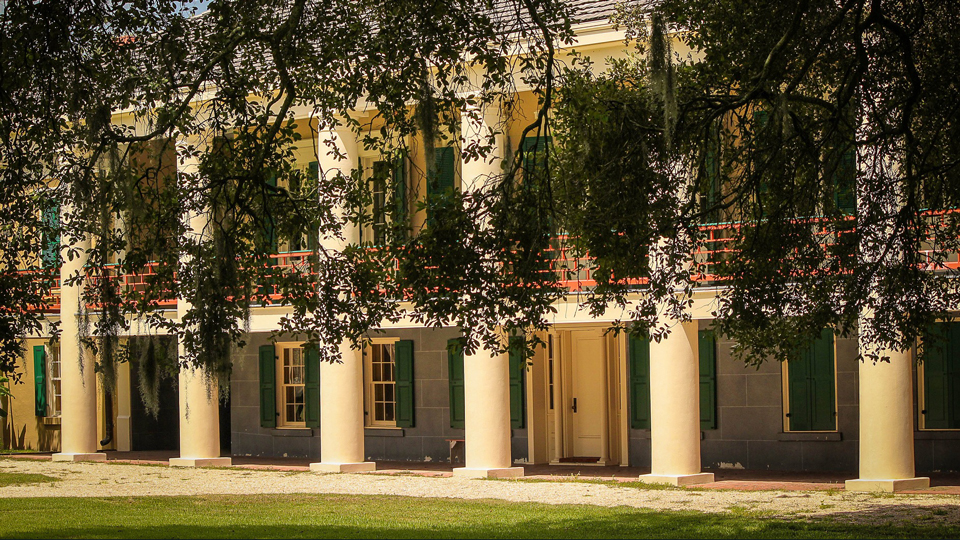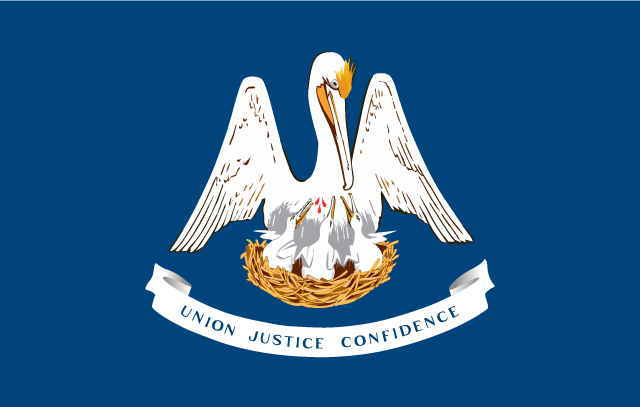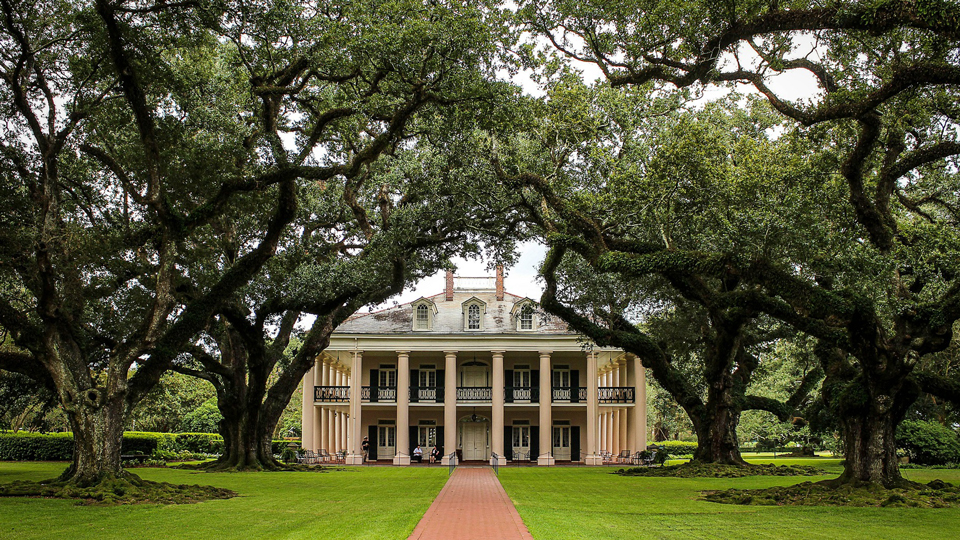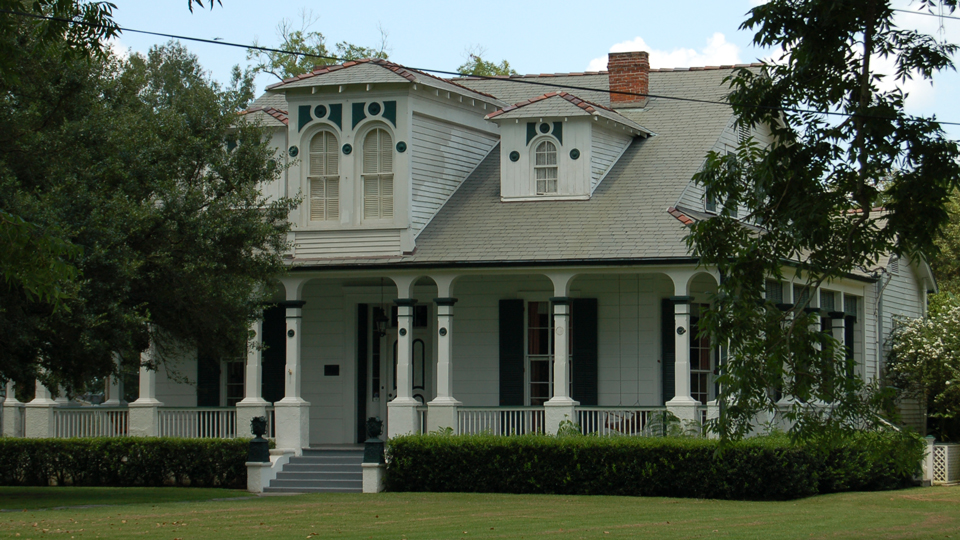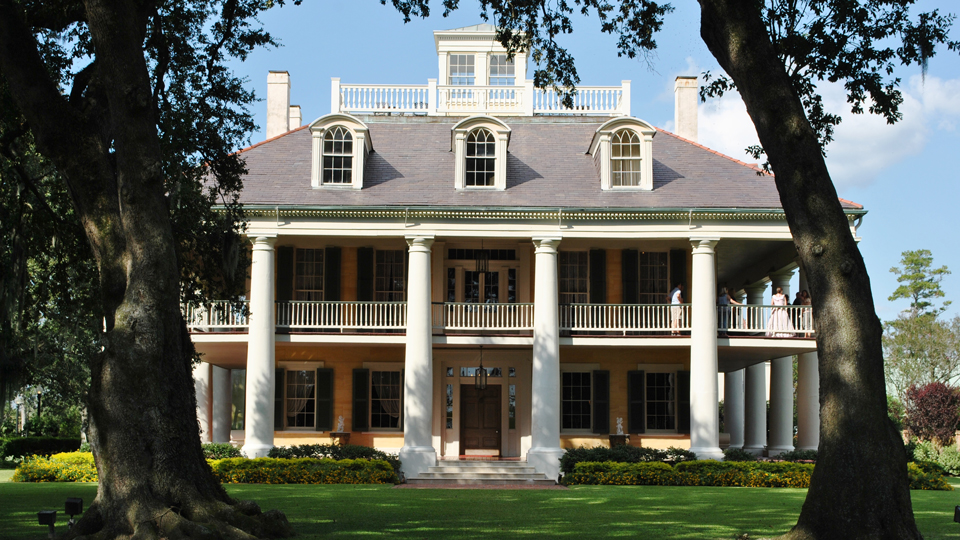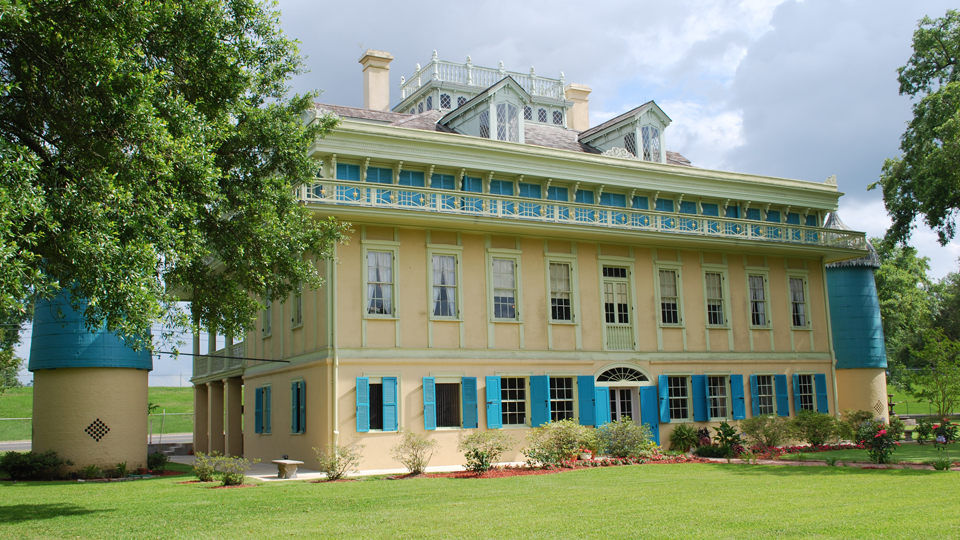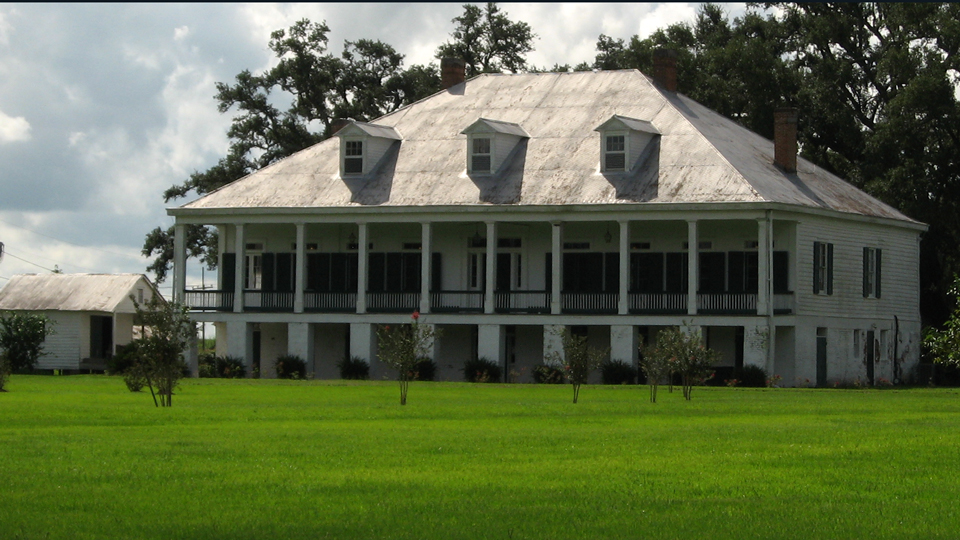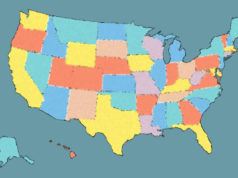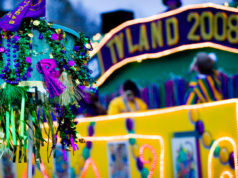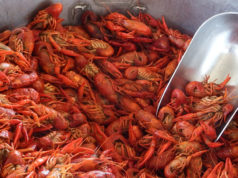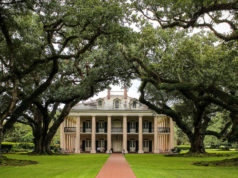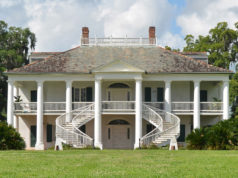Destrehan Plantation is an antebellum mansion designed in French Colonial style with out buildings to support the plantation’s indigo production and processing activities. It was completed in 1790 for Robin de Logny, Commandant of the German Coast settlement north of New Orleans. Construction was by a mulatto slave called Charles Paquet, an experienced carpenter, with slave labor provided by the owner. The original construction contract is still on file at the St. Charles Parish Courthouse, making it the oldest documented building in the lower Mississippi Valley.
When Robin de Logny died in 1792, the plantation was sold to his son-in-law, Jean Noel Destrehan, who introduced sugar cane on the plantation. By 1803 Destrehan Plantation became the largest sugar cane producer in St. Charles parish.
Jean Noel and his wife Celeste had 14 children and lived in the house for over 30 years. During their residence they expanded the house in almost every direction, adding two semi-detached wings and enclosing the ground level of the house to accommodate the needs of their growing family.
Who was Jean Noel Destrehan?
The second master of Destrehan Plantation was more than a prominent business man and plantation owner. He was an active politician and leading voice in the Louisiana territory and a crusader for Lousiana statehood.
Jean Noel entered politics in the waning days of French rule when he was appointed Mayor of St. Charles Parish in 1803. He served as speaker of the Louisiana Territorial House of Representatives, President of the Orleans Territorial Council, and ran for Governor, placing second in the first election after statehood was granted in 1812. He was subsequently elected Senator from the State of Louisiana, the first to hold that office, but he resigned after only three weeks time. He continued to serve in the Louisiana State Senate until 1817.
Jean Noel Destrehan returned to his life as a planter and continued his career at Destrehan Plantation until his death in 1823. When he died, he left one of the largest estates in Louisiana at that time.
Later History of the Destrehan Plantation
Jean Noel was succeeded at the plantation by his son-in-law, Stephen Henderson, a Scottish immigrant who arrived penniless but became a wealthy entrepreneur. He was 42 when he married 16 year old Zelia Destrehan in 1816, and became part owner of the plantation in 1825 along with some of his wife’s siblings. Zelia died childless in 1830. Henderson continued to manage the plantation, eventually gaining full control of the property in 1836. He died in 1838.
Stephen Henderson left an unorthodox and controversial will stipulating that all of his slaves should be freed and, if they so desired, be given passage to Liberia. In addition, a factory was to be established to provide employment for any who chose to stay after being freed. The family challenged the will in court, and in 1850 it was set aside on a legal technicality.
Henderson’s brother-in-law Pierre Adolfe Rost purchased the plantation from his estate in 1839 and moved in with his wife and family. They remodeled the home in Greek Revival style, which was popular at the time, and remained there until the outbreak of the Civil War, when Rost became the Confederate States of America diplomatic representative to Spain.
At the end of the civil War the property was seized by the Freedman’s Bureau and became the Rost Home Colony, a facility to provide services and education to freed slaves. Rost returned from Spain, secured a pardon from President Andrew Johnson, and retrieved possession of his property, living there until his death in 1868.
His son Emile Rost, grandson of Jean Noel Destrehan, inherited the home and stayed living there with his wife until it was sold in 1910 to the Destrehan Planting and Manufacturing Company, ending family ownership of the plantation.
The property passed through the hands of several different corporate entities and eventually fell into disuse, disrepair and suffered severe looting. In 1971 it was acquired by the River Road Historical Society.
Destrehan Plantation Today
Today the Destrehan Plantation is open to visitors who want to discover the historical legacy of Louisiana plantations. The house is open daily for guided tours, and the land surrounding the house has been developed to recreate the plantation community surrounding the plantation house during its heyday.
Destrehan Plantation was listed in the National Register of Historic Places on 20 March 1973.
Visit Destrehan Plantation
The restored plantation house and surroundings are open to visitors daily, offering tours, demonstrations, and historical interpretation of life and history at Destrehan Plantation. Visitors are encouraged to stroll the grounds, which includes oak trees over 200 years old.
Contact Information
Destrehan Plantation
13034 River Road
Destrehan, Louisiana 70047
Phone: +1 (985) 764-9315
Fax: +1 (985) 725-1929
email: info@destrehanplantation.org
web: www.destrehanplantation.org
Hours of Operation
Daily 09:00-17:00
Closed on the following holidays: New Years Day, Mardi Gras Day, Easter Sunday, Thanksgiving, Christmas Eve, and Christmas Day.
The first demonstration begins at 09:15.
The first tour begins at 09:30 and the last tour begins at 16:00. The tour takes about 45 minutes.
Grounds close daily at 17:00.
Admission
Admission fees include a guided tour of the plantation house and access to the Jefferson Room, the Herbert J Harvey, Jr. Legacy Room, the 1811 Slave revolt exhibit, the grounds, outlying buildings and folk-life demonstrations.
General Admission: $20.00
AAA Auto Club: $16.00
Active Military: $16.00
Senior Citizens (60 and over): $15.00
Children 7-17: $7.00
Children under 7: Free
Reservations required for groups of 20 or more.
Guided Tours
Tours start every 30 minutes from 09:30-16:00
Tours are led by costumed guides and take about 45 minutes.
Book a tour online.
Folk-life Demonstrations
Demostrations include:
Bousillage
Quilting
Weaving
18th and 19th Century Fashion
African American Herbal Remedies
Historical Carpentry
Art and History of the Tignon
Art and History of Barrel Making
Demonstrations subject to regular schedule changes.
For the latest schedule, check online or call the office at +1 (985) 764-9315.
Exhibits
The Jefferson Room Displaying the original document signed by Thomas Jefferson and James Madison appointing four men, including Jean Noel Destrehan, to serve on the Orleans Territorial Council.
The Herbert J. Harvey, Jr. Legacy Room Displaying original documents and artifacts of the Destrehan family.
The Education Center Museum housing the 1811 Slave Revolt exhibit. Originally slave overseer quarters.
The Outdoor Kitchen Replica rebuilt in its original location. Houses cooking and candle making demonstrations.
The Helvetia Slave Cabins Relocated from Helvetia Plantation, destroyed by storm in 1965. Exhibit slave quarters and a 19th century cooper shop.
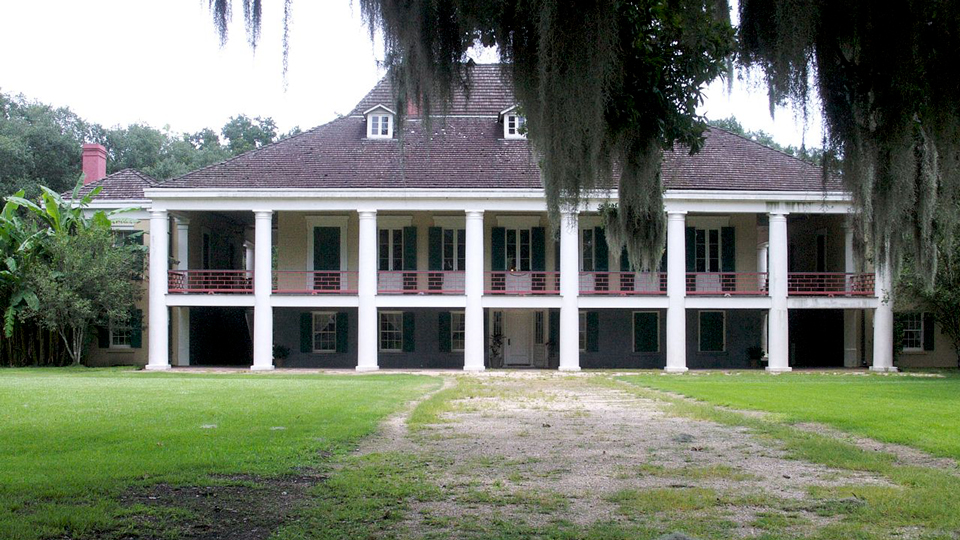
Visit These New Orleans Plantation Country Homes
Destrehan Plantation Destrehan Daily house tours. 1811 Slave Revolt exhibit. See an historic document signed by Thomas Jefferson. +1 (985) 764-9315.
Ormond Plantation Destrehan Home Historic 1877 home built in a rare West Indies style. Rich history, antique furnishings, ghost stories. +1 (985) 764-8544.
San Francisco Plantation Garyville One of the most opulent and distinctive plantation homes in the American South. +1 (985) 535-2341.
Evergreen Plantation Edgard The most intact plantation complex in the American South. 37 national landmark buildings, 22 original slave cabins. +1 (985) 497-3837.
Whitney Plantation Wallace Site focuses on the lives of slaves. Last surviving French Creole barn. Listed in the National Register of Historic Places. +1 (225) 265-3000.
Laura Plantation Vacherie History comes alive on house tours of this 1805 Creole plantation. A leading interpretive voice on the Creole slave experience. +1 (225) 265-7690.
St. Joseph Plantation Vacherie A working Creole sugar plantation. Hear authentic stories about plantation life from descendants of a 19th century owner. +1 (225) 265-4078.
Oak Alley Plantation Vacherie Famous for its 1/4 mile long alley of 300 year old oak trees. Big House tour. +1 (225) 265-2151.
Poche Plantation Convent A Victorian Renaissance Revival building, one of the last plantations built on the Mississippi River. RV resort. +1 (225) 562-7728.
Houmas House Plantation & Gardens Darrow “The Sugar Palace,” a grand antebellum estate with 37 acres of gardens. Period antiques and artwork. +1 (225) 473-9380.
Planning to visit Louisiana?
Visit our Louisiana state travel destination page for all your information needs, including news, ideas, advice, and links.
Just Browsing? Go back to the narangah Travel home page to uncover a wealth of travel information about destinations near and far. Imagine yourself there, and let us take you exploring around the world!

